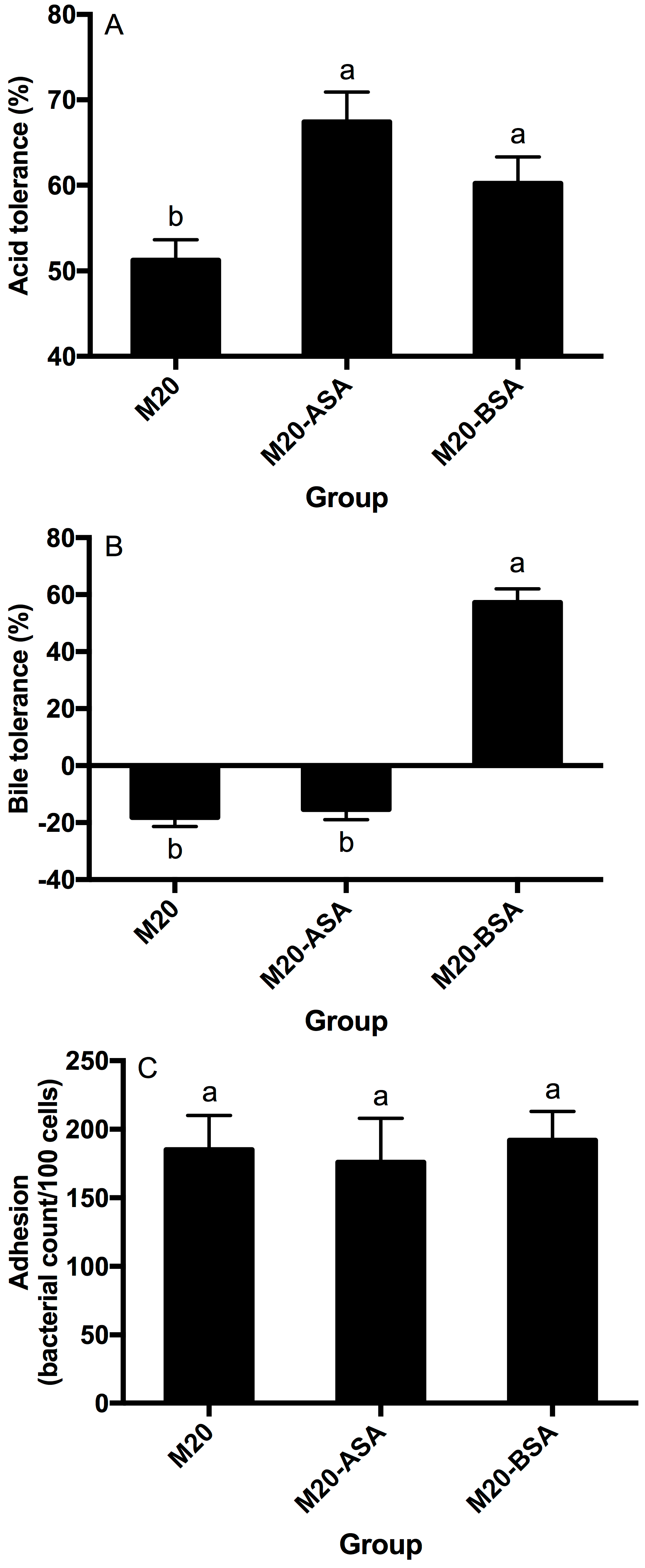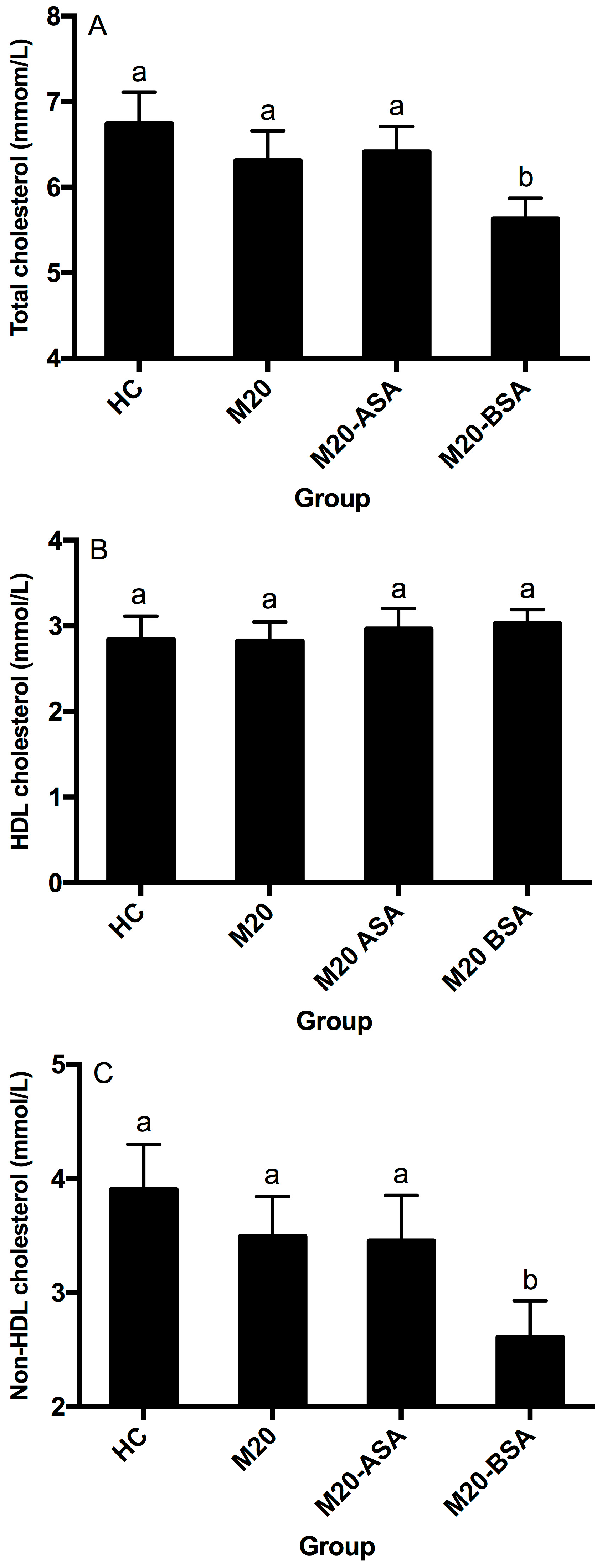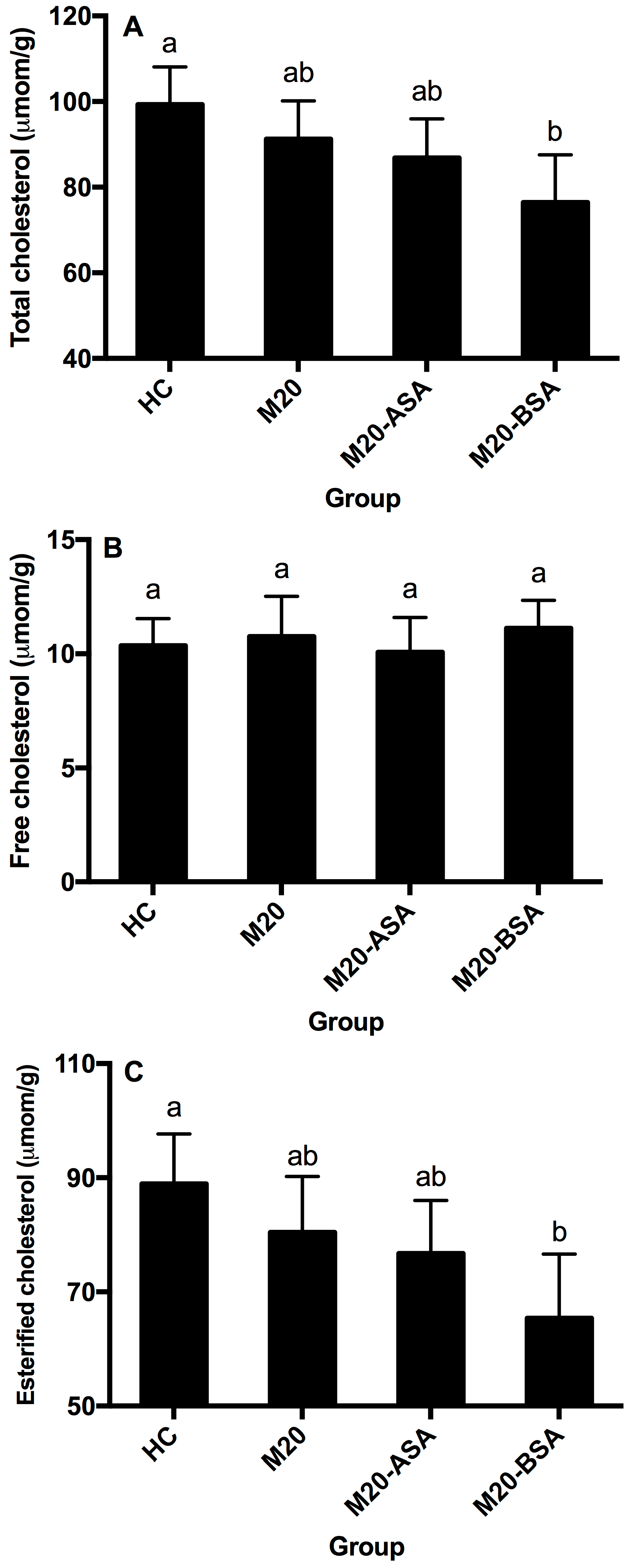Lactobacillus Kefir M20 Adaptation to Bile Salts: A Novel Pathway for Cholesterol Reduction
Abstract
1. Introduction
2. Materials and Methods
2.1. Origin and Maintenance Condition of Strain
2.2. Stress Adaptation Treatments
2.3. Assay for Acid Tolerance
2.4. Assay for Bile Tolerance
2.5. Assay for Adhesion Ability
2.6. Assay for Bile Salt Hydrolase Activity
2.7. Assay for Membrane Fatty Acid Composition
2.8. Animals and Grouping
2.9. Assay for Serum Lipids
2.10. Assay for Hepatic Lipids
2.11. Assay for Fecal Bile Acids
2.12. Statistical Analysis
3. Results
3.1. Effects of In Vitro Acid and Bile Stress Adaption Treatments on Probiotic Properties of the Strain
3.2. Effects of In Vitro Acid and Bile Stress Adaption Treatments on Bile Salt Hydrolase Activity of the Strain
3.3. Effect of the Acid and Bile Stress Adaption Treatments on Membrane Fatty Acid Composition of the Strain
3.4. Effect of the Acid and Bile Stress Adaption Treatments on Cholesterol-Lowering Ability of the Strain
3.5. Effect of the Acid and Bile Stress Adaption on Liver Cholesterol-Lowering Ability of the Strain
3.6. Effect of the Acid and Bile Stress Adaption Treatments on Fecal Bile Acid Excretion in the Animals
4. Discussion
5. Conclusions
Author Contributions
Funding
Institutional Review Board Statement
Informed Consent Statement
Data Availability Statement
Conflicts of Interest
Appendix A
| Instrument/Equipment | Manufacturer | Origin |
|---|---|---|
| Inverted Microscope | Nikon | Tokyo, Japan |
| SW-CJ-IF Laminar Flow Clean Bench | Beijing Donglian Harl | Beijing, China |
| Low-Temperature Centrifuge | Eppendorf | Germany |
| Precision Constant Temperature Water Bath | Beijing Deyouke | Beijing, China |
| SHP-250 Constant Temperature Incubator | Shanghai Peiyin | Shanghai, China |
| 4 °C Low-Temperature Refrigerator | Changhong Meiling | Hefei, China |
| −80 °C Ultra-Low Temperature Freezer | Changhong Meiling | Hefei, China |
| Mill-Q Ultrapure Water System | Millipore | St. Louis, MO, USA |
| Gel Imaging Analysis System | Bio-Rad | Shoreline, WA, USA |
| Electronic Balance | Sartorius BSA | Tagelswangen, Switzerland |
| Microplate Reader | Tecan | Männedorf, Switzerland |
| pH Meter | Sartorius BSA | Tagelswangen, Switzerland |
| Small Vertical Electrophoresis System | Bio-Rad | Shoreline, WA, USA |
| PCR Machine | Thermo Fisher | Waltham, MA, USA |
| Magnetic Stirrer with Heating | IKA | Wilmington, NC, USA |
| Fully Automatic Sterilizer | Saiwei | Fujian, China |
| CO2 Cell Culture Incubator | Binder | Tuttlingen, Germany |
| Fluorescent Quantitative PCR Machine | Analytikjena | Jena, Germany |
| Reagent Name | Manufacturer | Origin |
|---|---|---|
| Glycerol (Analytical Pure) | Solarbio | Beijing, China |
| Gram Staining Solution | Sia | Shandong, China |
| Bacterial Genome Extraction Kit | Tiangen | Beijing, China |
| Lysozyme | Tiangen | Beijing, China |
| Lysozyme Buffer Solution | Shenggong | Shanghai, China |
| Taqmix | JinbaiTe | Beijing, China |
| DL5000 Marker | Shenggong | Shanghai, China |
| Gentamicin Sensitivity Discs | Tianhe | Hangzhou, China |
| Ampicillin Sensitivity Discs | Tianhe | Hangzhou, China |
| Ceftazidime Sensitivity Discs | Tianhe | Hangzhou, China |
| Penicillin Sensitivity Discs | Tianhe | Hangzhou, China |
| Vancomycin Sensitivity Discs | Tianhe | Hangzhou, China |
| Piperacillin Sensitivity Discs | Tianhe | Hangzhou, China |
| Amikacin Sensitivity Discs | Tianhe | Hangzhou, China |
| Trypsin | Biyuntian | Shanghai, China |
| SYBR Green | Tiangen | Beijing, China |
References
- DiRienzo, D.B. Effect of probiotics on biomarkers of cardiovascular disease: Implications for heart-healthy diets. Nutr. Rev. 2014, 72, 18–29. [Google Scholar] [CrossRef] [PubMed]
- Singhal, N.; Singh, N.S.; Mohanty, S.; Kumar, M.; Virdi, J.S. Rhizospheric Lactobacillus plantarum (Lactiplantibacillus plantarum) strains exhibit bile salt hydrolysis, hypocholestrolemic and probiotic capabilities in vitro. Sci. Rep. 2021, 11, 15288. [Google Scholar] [CrossRef] [PubMed]
- Kumar, M.; Nagpal, R.; Kumar, R.; Hemalatha, R.; Verma, V.; Kumar, A.; Chakraborty, C.; Singh, B.; Marotta, F.; Jain, S.; et al. Corrigendum to “Cholesterol-Lowering Probiotics as Potential Biotherapeutics for Metabolic Diseases”. J. Diabetes Res. 2022, 2022, 3952529. [Google Scholar] [CrossRef] [PubMed]
- Devi, S.M.; Kurrey, N.K.; Halami, P.M. In vitro anti-inflammatory activity among probiotic Lactobacillus species isolated from fermented foods. J. Funct. Foods 2018, 47, 19–27. [Google Scholar] [CrossRef]
- Zhang, Z.-w.; Lv, J.-l.; Pan, L.; Zhang, Y. Roles and applications of probiotic Lactobacillus strains. Appl. Microbiol. Biotechnol. 2018, 102, 8135–8143. [Google Scholar] [CrossRef]
- Wang, Y.; Xu, N.; Xi, A.; Ahmed, Z.; Zhang, B.; Bai, X. Effects of Lactobacillus plantarum MA2 isolated from Tibet kefir on lipid metabolism and intestinal microflora of rats fed on high-cholesterol diet. Appl. Microbiol. Biotechnol. 2009, 84, 341–347. [Google Scholar] [CrossRef]
- Guo, C.-F.; Yuan, Y.-H.; Yue, T.-L.; Li, J.-Y. Hamsters Are a Better Model System than Rats for Evaluating the Hypocholesterolemic Efficacy of Potential Probiotic Strains. Mol. Nutr. Food Res. 2018, 62, 1800170. [Google Scholar] [CrossRef]
- Jones, M.L.; Martoni, C.J.; Parent, M.; Prakash, S. Cholesterol-lowering efficacy of a microencapsulated bile salt hydrolase-active Lactobacillus reuteri NCIMB 30242 yoghurt formulation in hypercholesterolaemic adults. Br. J. Nutr. 2012, 107, 1505–1513. [Google Scholar] [CrossRef]
- Fuentes, M.C.; Lajo, T.; Carrión, J.M.; Cuñé, J. Cholesterol-lowering efficacy of Lactobacillus plantarum CECT 7527, 7528 and 7529 in hypercholesterolaemic adults. Br. J. Nutr. 2013, 109, 1866–1872. [Google Scholar] [CrossRef]
- Lye, H.S.; Rahmat-Ali, G.R.; Liong, M.-T. Mechanisms of cholesterol removal by lactobacilli under conditions that mimic the human gastrointestinal tract. Int. Dairy J. 2010, 20, 169–175. [Google Scholar] [CrossRef]
- Kumar, M.; Nagpal, R.; Kumar, R. Cholesterol-lowering probiotics as potential biotherapeutics for metabolic diseases. Exp. Diabetes Res. 2012, 2012, 902–917. [Google Scholar] [CrossRef] [PubMed]
- Keuler, T.; Wolf, V.; Lemke, C.; Voget, R.; Braune, A.; Gütschow, M. Fluorogenic substrates and pre-column derivatization for monitoring the activity of bile salt hydrolase from Clostridium perfringens. Bioorganic Chem. 2023, 138, 106574. [Google Scholar] [CrossRef] [PubMed]
- Patel, A.K.; Singhania, R.R.; Pandey, A.; Chincholkar, S.B. Probiotic Bile Salt Hydrolase: Current Developments and Perspectives. Appl. Biochem. Biotechnol. 2010, 162, 166–180. [Google Scholar] [CrossRef] [PubMed]
- Chen, Z.-Y.; Ma, K.Y.; Liang, Y.; Peng, C.; Zuo, Y. Role and classification of cholesterol-lowering functional foods. J. Funct. Foods 2011, 3, 61–69. [Google Scholar] [CrossRef]
- Jones, M.L.; Tomaro-Duchesneau, C.; Martoni, C.J.; Prakash, S. Cholesterol lowering with bile salt hydrolase-active probiotic bacteria, mechanism of action, clinical evidence, and future direction for heart health applications. Expert Opin. Biol. Ther. 2013, 13, 631–642. [Google Scholar] [CrossRef]
- Majeed, M.; Majeed, S.; Nagabhushanam, K.; Arumugam, S.; Beede, K.; Ali, F. Evaluation of the in vitro cholesterol-lowering activity of the probiotic strain Bacillus coagulansMTCC 5856. Int. J. Food Sci. Technol. 2018, 54, 212–220. [Google Scholar] [CrossRef]
- Sridevi, N.; Vishwe, P.; Prabhune, A. Hypocholesteremic effect of bile salt hydrolase from Lactobacillus buchneri ATCC 4005. Food Res. Int. 2009, 42, 516–520. [Google Scholar] [CrossRef]
- Javed, S.; Munir, A.; Javed, G.A.; Latif, Z.; Javed, S.; Arshad, N. Genetic diversity, cholesterol reduction, and presence of conserved bile salt hydrolase gene in probiotic strains from human milk. Lett. Appl. Microbiol. 2023, 76, ovad024. [Google Scholar] [CrossRef]
- Romero-Luna, H.E.; Peredo-Lovillo, A.G.; Jiménez-Fernández, M. Probiotic and Potentially Probiotic Bacteria with Hypocholesterolemic Properties. Food Rev. Int. 2023, 39, 689–707. [Google Scholar] [CrossRef]
- Han, Q.; Kong, B.; Chen, Q.; Sun, F.; Zhang, H. In vitro comparison of probiotic properties of lactic acid bacteria isolated from Harbin dry sausages and selected probiotics. J. Funct. Foods 2017, 32, 391–400. [Google Scholar] [CrossRef]
- Hu, P.-L.; Yuan, Y.-H.; Yue, T.-L.; Guo, C.-F. A new method for the in vitro determination of the bile tolerance of potentially probiotic lactobacilli. Appl. Microbiol. Biotechnol. 2018, 102, 1903–1910. [Google Scholar] [CrossRef] [PubMed]
- Pan, X.; Chen, F.; Wu, T.; Tang, H.; Zhao, Z. The acid, bile tolerance and antimicrobial property of Lactobacillus acidophilus NIT. Food Control 2009, 20, 598–602. [Google Scholar] [CrossRef]
- Tanaka, H.; Hashiba, H.; Kok, J.; Mierau, I. Bile Salt Hydrolase of Bifidobacterium longum—Biochemical and Genetic Characterization. Appl. Environ. Microbiol. 2000, 66, 2502–2512. [Google Scholar] [CrossRef] [PubMed]
- Rossi, S.S.; Converse, J.L.; Hofmann, A.F. High pressure liquid chromatographic analysis of conjugated bile acids in human bile: Simultaneous resolution of sulfated and unsulfated lithocholyl amidates and the common conjugated bile acids. J. Lipid Res. 1987, 28, 589–595. [Google Scholar] [CrossRef] [PubMed]
- Moss, C.W. Gas-liquid chromatography as an analytical tool in microbiology. J. Chromatogr. A 1981, 203, 337–347. [Google Scholar] [CrossRef] [PubMed]
- Guerzoni, M.E.; Lanciotti, R.; Cocconcelli, P.S. Alteration in cellular fatty acid composition as a response to salt, acid, oxidative and thermal stresses in Lactobacillus helveticus. Microbiology 2001, 147, 2255–2264. [Google Scholar] [CrossRef]
- Tian, L.; Liu, R.; Zhou, Z.; Xu, X.; Feng, S.; Kushmaro, A.; Marks, R.S.; Wang, D.; Sun, Q. Probiotic Characteristics of Lactiplantibacillus Plantarum N-1 and Its Cholesterol-Lowering Effect in Hypercholesterolemic Rats. Probiotics Antimicrob. Proteins 2022, 14, 337–348. [Google Scholar] [CrossRef]
- Guo, C.-F.; Zhao, D.; Yuan, Y.-H.; Yue, T.-L.; Liu, B.; Li, J.-Y. Lactobacillus casei-fermented milk improves serum and hepatic lipid profiles in diet-induced hypercholesterolaemic hamsters. J. Funct. Foods 2016, 26, 691–697. [Google Scholar] [CrossRef]
- Dhameliya, H.A.; Thakkar, V.R.; Subramanian, R.B. Bile salt deconjugation and in-vitro cholesterol-lowering ability of probiotic bacteria isolated from buttermilk. Food Biotechnol. 2022, 36, 351–370. [Google Scholar] [CrossRef]
- Doleyres, Y.; Lacroix, C. Technologies with free and immobilised cells for probiotic bifidobacteria production and protection. Int. Dairy J. 2005, 15, 973–988. [Google Scholar] [CrossRef]
- Ansari, F.; Pourjafar, H. Comments on symbiotic microencapsulation to enhance Lactobacillus acidophilus survival. LWT 2018, 96, 526. [Google Scholar] [CrossRef]
- Ferrando, V.; Quiberoni, A.; Reinheimer, J.; Suárez, V. Functional properties of Lactobacillus plantarum strains: A study in vitro of heat stress influence. Food Microbiol. 2016, 54, 154–161. [Google Scholar] [CrossRef]
- Morelli, L. In vitro assessment of probiotic bacteria: From survival to functionality. Int. Dairy J. 2007, 17, 1278–1283. [Google Scholar] [CrossRef]
- Chen, M.-J.; Tang, H.-Y.; Chiang, M.-L. Effects of heat, cold, acid and bile salt adaptations on the stress tolerance and protein expression of kefir-isolated probiotic Lactobacillus kefiranofaciens M1. Food Microbiol. 2017, 66, 20–27. [Google Scholar] [CrossRef] [PubMed]
- Kiriyama, Y.; Nochi, H. Physiological Role of Bile Acids Modified by the Gut Microbiome. Microorganisms 2022, 10, 68. [Google Scholar] [CrossRef]
- Kimoto-Nira, H.; Suzuki, S.; Yakabe, T.; Suzuki, C. Relationships between fatty acid composition and bile tolerance in lactobacillus isolates from plants and from non-plant materials. Can. J. Microbiol. 2012, 58, 1396–1404. [Google Scholar] [CrossRef]
- Begley, M.; Gahan, C.G.M.; Hill, C. The interaction between bacteria and bile. FEMS Microbiol. Rev. 2005, 29, 625–651. [Google Scholar] [CrossRef]
- Koskenniemi, K.; Laakso, K.; Koponen, J.; Kankainen, M.; Greco, D.; Auvinen, P.; Savijoki, K.; Nyman, T.A.; Surakka, A.; Salusjärvi, T.; et al. Proteomics and Transcriptomics Characterization of Bile Stress Response in Probiotic Lactobacillus rhamnosus GG*. Mol. Cell. Proteom. 2011, 10, S1–S18. [Google Scholar] [CrossRef]
- Lv, L.-X.; Yan, R.; Shi, H.-Y.; Shi, D.; Fang, D.-Q.; Jiang, H.-Y.; Wu, W.-R.; Guo, F.-F.; Jiang, X.-W.; Gu, S.-L.; et al. Integrated transcriptomic and proteomic analysis of the bile stress response in probiotic Lactobacillus salivarius LI01. J. Proteom. 2017, 150, 216–229. [Google Scholar] [CrossRef]
- Kimoto-Nira, H.; Kobayashi, M.; Nomura, M.; Sasaki, K.; Suzuki, C. Bile resistance in Lactococcus lactis strains varies with cellular fatty acid composition: Analysis by using different growth media. Int. J. Food Microbiol. 2009, 131, 183–188. [Google Scholar] [CrossRef]
- Bustos, A.Y.; de Valdez, G.F.; Raya, R.; de Almeida, A.M.; Fadda, S.; Taranto, M.P. Proteomic analysis of the probiotic Lactobacillus reuteri CRL1098 reveals novel tolerance biomarkers to bile acid-induced stress. Food Res. Int. 2015, 77, 599–607. [Google Scholar] [CrossRef]
- Yuan, J.; Wang, B.; Sun, Z.; Bo, X.; Yuan, X.; He, X.; Zhao, H.; Du, X.; Wang, F.; Jiang, Z.; et al. Analysis of Host-Inducing Proteome Changes in Bifidobacterium longum NCC2705 Grown in Vivo. J. Proteome Res. 2008, 7, 375–385. [Google Scholar] [CrossRef] [PubMed]
- Jones, B.V.; Begley, M.; Hill, C.; Gahan, C.G.M.; Marchesi, J.R. Functional and comparative metagenomic analysis of bile salt hydrolase activity in the human gut microbiome. Proc. Natl. Acad. Sci. USA 2008, 105, 13580–13585. [Google Scholar] [CrossRef] [PubMed]
- Guo, C.-F.; Zhang, S.; Yuan, Y.-H.; Li, J.-Y.; Yue, T.-L. Bile Salt Hydrolase and S-Layer Protein Are the Key Factors Affecting the Hypocholesterolemic Activity of Lactobacillus Casei-Fermented Milk in Hamsters. Mol. Nutr. Food Res. 2018, 62, 1800728. [Google Scholar] [CrossRef]






Disclaimer/Publisher’s Note: The statements, opinions and data contained in all publications are solely those of the individual author(s) and contributor(s) and not of MDPI and/or the editor(s). MDPI and/or the editor(s) disclaim responsibility for any injury to people or property resulting from any ideas, methods, instructions or products referred to in the content. |
© 2024 by the authors. Licensee MDPI, Basel, Switzerland. This article is an open access article distributed under the terms and conditions of the Creative Commons Attribution (CC BY) license (https://creativecommons.org/licenses/by/4.0/).
Share and Cite
Ma, C.; Liu, Q.; Zhang, S.; Qu, A.; Liu, Q.; Lv, J.; Pang, X. Lactobacillus Kefir M20 Adaptation to Bile Salts: A Novel Pathway for Cholesterol Reduction. Foods 2024, 13, 3380. https://doi.org/10.3390/foods13213380
Ma C, Liu Q, Zhang S, Qu A, Liu Q, Lv J, Pang X. Lactobacillus Kefir M20 Adaptation to Bile Salts: A Novel Pathway for Cholesterol Reduction. Foods. 2024; 13(21):3380. https://doi.org/10.3390/foods13213380
Chicago/Turabian StyleMa, Changlu, Qichen Liu, Shuwen Zhang, Ailing Qu, Qing Liu, Jiaping Lv, and Xiaoyang Pang. 2024. "Lactobacillus Kefir M20 Adaptation to Bile Salts: A Novel Pathway for Cholesterol Reduction" Foods 13, no. 21: 3380. https://doi.org/10.3390/foods13213380
APA StyleMa, C., Liu, Q., Zhang, S., Qu, A., Liu, Q., Lv, J., & Pang, X. (2024). Lactobacillus Kefir M20 Adaptation to Bile Salts: A Novel Pathway for Cholesterol Reduction. Foods, 13(21), 3380. https://doi.org/10.3390/foods13213380








